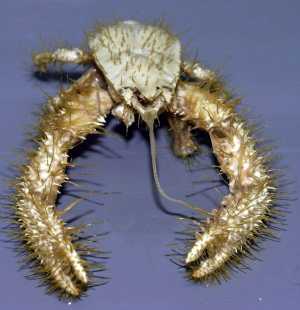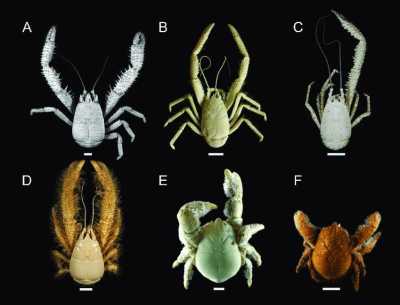10 curiosities about the Yeti Crab
The Yeti crab also known as Kiwa hirsuta, is a fascinating and unusual deep-sea creature that was first discovered in 2005. This species of crab has become a subject of intense interest and study among marine biologists due to its unique appearance, habitat and behaviors. As one of the first animals discovered to depend on chemosynthesis for its food, the Yeti crab has provided important insights into the ecology of deep-sea environments.
Let's explore 10 curiosities about the Yeti crab, including its diet, social behavior, reproductive strategy, and potential applications for human health. Join us on a journey to discover the wonders of this fascinating creature that lives in the depths of the ocean.
-
Unique Appearance
The Yeti crab, also known as Kiwa hirsuta is a species of deep-sea crab that was first discovered in 2005. This crab has a unique appearance, with its body and legs covered in long, blonde hair-like strands called setae, which give it a furry or "yeti-like" appearance. The setae are covered in filamentous bacteria that the crab cultivates and uses to detoxify the poisonous minerals found in the hydrothermal vents where it lives.
-
Exclusive Habitat
The Yeti crab is found in only a few places in the world specifically around hydrothermal vents on the East Pacific Rise in the Pacific Ocean. These vents release hot, mineral-rich water, which creates a unique environment that is home to many unusual creatures, including the Yeti crab.
-
Unusual Diet
The Yeti crab has a unique diet, feeding on the bacteria that grow on its setae. The crab holds its claws open to catch the bacteria, and then uses comb-like mouthparts to scrape the bacteria into its mouth. The bacteria are then digested in the crab's stomach providing the crab with the nutrients it needs to survive in its extreme environment.
-
Matriarchal Society
The Yeti crab is known for its unusual social behavior, which is dominated by females. Researchers have found that female Yeti crabs are much larger than males, and they form groups around hydrothermal vents. These groups are led by a dominant female, who is responsible for protecting her group's territory and ensuring the survival of the group.
-
Important Discovery
The discovery of the Yeti crab was an important moment in marine biology, as it was one of the first animals found to depend on chemosynthesis rather than photosynthesis for its food. Chemosynthesis is the process by which organisms use chemicals rather than sunlight to create energy and it is an important process in deep-sea environments where there is no sunlight. The Yeti crab's ability to cultivate bacteria on its setae and use them for food has provided important insights into the ecology of deep-sea environments.
 Andrew Thurber, Oregon State University, CC BY-SA 2.0, via Wikimedia Commons
Andrew Thurber, Oregon State University, CC BY-SA 2.0, via Wikimedia Commons
-
Slow Growth and Long Lifespan
Yeti crabs are slow-growing animals that take several years to reach maturity. However once they reach adulthood, they have a long lifespan, with some individuals living for more than 20 years. This slow growth and long lifespan may be an adaptation to the harsh conditions in their deep-sea environment, where food and resources are scarce.
-
Unusual Reproductive Strategy
Researchers have found that Yeti crabs have an unusual reproductive strategy. Females lay their eggs on their setae, where they are carried until they hatch into larvae. The larvae are then released into the water, where they drift with the currents until they settle on the seafloor and begin their life as a juvenile crab. This reproductive strategy may be an adaptation to the deep-sea environment, where finding a mate and caring for offspring can be difficult.
-
Impact of Deep-Sea Mining
The habitat of the Yeti crab and other deep-sea creatures is under threat from deep-sea mining, a process that involves extracting minerals from the seafloor. The mining process can disrupt the delicate ecosystems that exist around hydrothermal vents, potentially causing irreparable damage to these unique environments. Conservation efforts are underway to protect these habitats and the animals that depend on them, including the Yeti crab.
-
Unique Adaptations to Extreme Environment
The Yeti crab has many unique adaptations that allow it to survive in its extreme deep-sea environment. For example its setae are covered in filamentous bacteria that help the crab detoxify the poisonous minerals found in the hydrothermal vents. Its comb-like mouthparts are also adapted to scrape bacteria from its setae and its large size and strong claws allow it to defend itself and compete for resources in a harsh environment.
-
Potential for Medical Applications
The bacteria that grow on the setae of the Yeti crab may have potential medical applications. Researchers have found that some of these bacteria produce compounds that have antibiotic properties, which could be useful in the development of new antibiotics to treat drug-resistant infections. The study of deep-sea creatures like the Yeti crab may therefore have important implications for human health and medicine.
The Yeti crab is a remarkable and intriguing creature that has captured the imagination of scientists and the public alike. Its unique adaptations to the extreme environment of the deep sea, its unusual reproductive strategy, and its potential medical applications are just a few of the many curiosities that make the Yeti crab such a fascinating subject of study.
As we continue to explore the mysteries of the deep sea the Yeti crab serves as a reminder of the incredible diversity of life that exists in our oceans, and the importance of protecting these fragile ecosystems for generations to come.
If you want to read more about this fascinating creature, we recommend the following read: A new yeti crab phylogeny: Vent origins with indications of regional extinction in the East Pacific
 Photographs of known kiwaid squat lobsters ("yeti crabs"). License: Creative Commons Attribution 4.0 International
Photographs of known kiwaid squat lobsters ("yeti crabs"). License: Creative Commons Attribution 4.0 International
A) Kiwa puravida modified from Thurber et al. [19] (CC BY 4.0); B) Kiwa sp. Galapagos Microplate; C) Kiwa araonae [28]; D) Kiwa hirsuta modified from Muséum National D'Histoire Naturelle (MNHN) crustacean collection-credit Noémy Mollaret (CC BY 4.0); E) Kiwa tyleri modified from Thatje et al. [23] (CC BY 4.0); (F) Kiwa sp. SWIR courtesy of David Shale. Scale bars are approximate and represent 10 mm.
